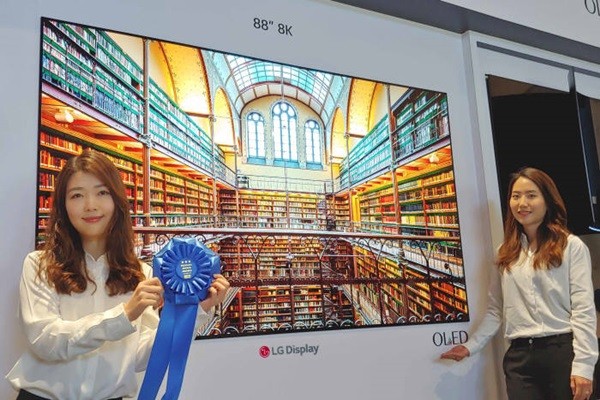Rapid evolution of LCD and OLED technologies and growth of micro LED ecosystem were seen through ‘SID Display Week 2019’ that was held in San Jose from the 14th to the 17th. There were many prototypes that were based on dual-cell LCD and mini LED technologies which suggested sustainability of LCD industry. Chinese businesses introduced improved version of inkjet printing OLED technology and proved that their technical skills are growing very rapidly.
◊Continuous evolution of LCD
Chinese and Taiwanese panel manufacturers suggested sustainability of LCD market by introducing dual-cell LCD and mini LED technologies.
Dual-cell LCD is a method that places a cell, which is comprised of a TFT (Thin Film Transistor), a color filter, and a liquid crystal, in duplicate and it provides deeper color and clearer images just like OLED. It also reduces reflection from a screen and provides clear images in a bright setting as well.
BOE presented a dual-cell structure called ‘BD Cell’ as its new LCD technology. Hisense is planning to introduce products with quantum-dot color filters that are applied to dual-cell LCD in 2020.
Mini LED is seen as a technology that can be applied to TVs and small and medium devices. It can be used as a BLU (Backlight Unit) that implements HDR (High Dynamic Range) or a LED without a liquid crystal. In 2018, AUO and Innolux presented examples of applying mini LED technology to monitors.
At this year’s SID, CSOT, Tianma, and BOE exhibited 8-inch flexible mini LED, 6-inch mini LED, and 65-inch mini LED with quantum-dot film and 15.6-inch UHD mini LED respectively.
“Dual-cell LCD technology does not require high degree of technologies and it can improve contrast ratio and color expression ability.” said a South Korean expert. “However, its weakness is high production cost due to complicated structure of a panel resulting in TV set manufacturers contemplating on its cost.”

◊Chinese businesses make rapid growth
While South Korean businesses were able to confirm their position when it comes to display technology at SID Display Week 2019, they were able to see that Chinese businesses are making rapid growth as well.
LG Display grabbed people’s attention through 88-inch 8K OLED, 65-inch rollable OLED TV, and 8K CSO (Crystal Sound OLED). Chinese, Taiwanese, and Japanese businesses were also able to show that they have secured advanced OLED technical skills.
88-inch 8K OLED was selected as the ‘Best New Display Technology’ during ‘People’s Choice Award’ that was held during the exhibition through votes from spectators.
BOE and CSOT drew interests by exhibiting prototypes of inkjet printing OLED with improved performance. Although many defective pixels were seen within BOE’s 55-inch inkjet OLED panel, it showed improved performance than last year and received ‘satisfactory’ comments.
Samsung Display did not attend this year’s exhibition due to reasons such as technology leak. Instead, it held ‘2019 Samsung AMOLED Forum’ at DSA (Device Solutions America) headquarters building that is located in San Jose and introduced OLED products and next-generation products for IT market. President Lee Dong-hoon visited SID, which is rare, and looked around the exhibition and held meetings with important businesses as well.
There were also many micro LED-related products and businesses at this year’s SID.
Plessey worked with a British quantum-dot material business called Nanoco and demonstrated micro LED based on non-cadmium quantum dot method. Quantum dot converted blue micro LED into green and red micro LED and reduced pixel size up to 87%.
SAPHLUX and ZeusOpto introduced color conversion solutions that combined micro LED and quantum dot (QD). PlayNitride exhibited 458ppi micro LED that is applied to Smart Watches and 28µm thin flexible micro LED.
“Although global display businesses are going through difficult times, size of this year’s SID increased by 8% compared to that of last year’s SID and number of spectators also increased from 6,500 people in 2018 to 8,000 people.” said former Chairman Kim Yong-seok of SID. “It seems that there were active interests and participations as display industry is going through a transition period through new technologies such as evolved OLED, micro LED, and mini LED.”
Staff Reporter Bae, Okjin | withok@etnews.com